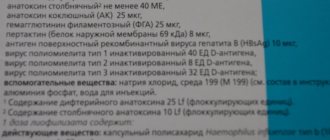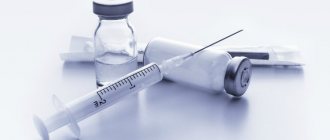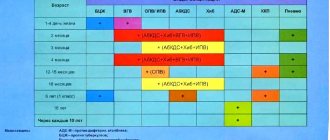Vaccination is so far the only reliable method of preventing dangerous diseases. Vaccinations begin from infancy. This allows a person to develop immunity and tolerate certain diseases more easily. Pediatricians often recommend that parents choose the Infanrix and Hexa vaccines. These drugs are produced by the same company, but they are different in composition. To decide which is better to vaccinate, you need to understand what Infanrix Hexa and Infanrix are, what are the differences and common features of these drugs.
Difference between Infanrix and Infanrix Hexa
These are Belgian-made vaccines.
Both drugs are recommended by WHO and are actively used in Russia for immunizing children. These tools have differences:
- in the composition;
- mechanism of action;
- dosage;
- list of adverse reactions;
- cost.
To understand which vaccine to give preference to, you need to consider the features of each drug and make a comparison.
Difference in composition
Infanrix and Infanrix Hexa differ in the content of active and additional components.
Infanrix contains the following main active ingredients:
- diphtheria toxoid – 30 IU;
- tetanus – 30 IU;
- pertussis – 25 mcg;
- filamentous hemagglutinin – 25 mcg.
Additional components: aqueous aluminum oxide - 0.5 mg, purified water - 0.5 mg, pertactin - 8 mcg and sodium chloride - 4.5 mcg.
Hexa contains the following active elements:
- diphtheria toxoid – 30 IU;
- tetanus – 40 IU;
- pertussis – 7.5 mcg;
- filamentous hemagglutinin – 25 mcg;
- inactivated polio virus of the first type - 40, second - 8, third - 31 units;
- hepatitis B virus antigen – 10 mcg;
- capsular polysaccharide Haemophilus influenzae type b conjugated with tetanus toxoid – 10 mcg.
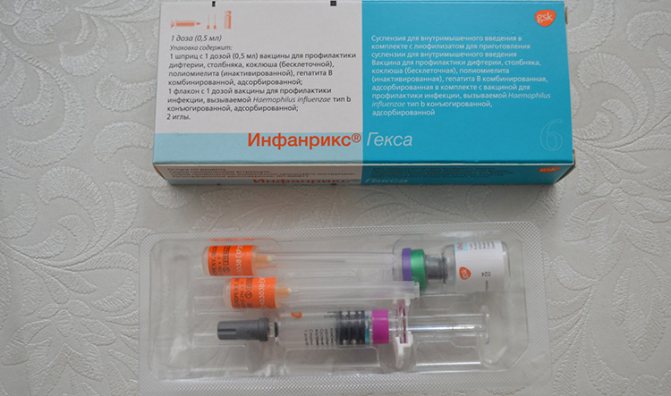
Additional components: hydrous aluminum oxide - 0.5 mg, Hanks' medium 199 - 0.09-1.15 mg, purified water - 0.5 mg, sodium chloride - 4.5 mg, aluminum phosphate - 0.2 mg and pertactin – 8 mcg.
Gex's composition is more complex. At the same time, the dosage of some components has been reduced.
Differences in mechanism of action
Infanrix - used for immunization against diphtheria, whooping cough and tetanus. Its analogue is Hexa. This drug contains antigens to protect against the diseases listed above and additionally against Haemophilus influenzae, polio and hepatitis B.
The mechanism of action of vaccines is almost the same. The only difference is that Infanrix promotes the development of protective forces against three diseases, and Hexa - against six.
When vaccine components enter the bloodstream, the immune system begins to activate and fight the virus. As a result of this reaction, antibodies are produced that protect the body from the development of pathology. A child vaccinated with these drugs will not get a viral infection or will tolerate it much easier, without complications.
How else do the drugs differ?
The differences between the drugs do not end with the composition and mechanism of action. There are also some differences in adverse reactions and costs.
Adverse events associated with Infanrix immunoprophylaxis:

- fever;
- swelling at the injection site, swelling of the limb;
- drowsiness;
- prolonged crying;
- nervousness;
- headache;
- convulsions;
- enlarged lymph nodes;
- increased body temperature;
- vomit;
- cough;
- stool disorder;
- respiratory arrest;
- hives;
- anaphylaxis;
- decreased platelet count;
- itching and rash in the injection area.
Hexa provokes similar adverse reactions and in addition can cause:
- weakness;
- unnatural crying;
- paralysis;
- inflammation of the meninges;
- damage to blood vessels;
- joint inflammation;
- papular dermatosis;
- inflammation of the brain.
The price of Infanrix is 740 rubles per dose. The cost of Hex is much higher and is equal to 1860 rubles per bottle.
Infanrix and Infanrix Hexa - what is the difference?
Pediatricians often recommend that parents have a choice of 2 vaccines - Infanrix and Infanrix Hexa. These drugs are produced by the same pharmacological company, but have different compositions. In order to decide which remedy is better, you need to know what these medications are and what the similarities and differences are.
Both vaccines are produced by the Belgian pharmaceutical company GlaxoSmithKline, are recommended by WHO and are actively used in Russia for immunization of children.
These medications differ in:
- composition;
- mechanism of action;
- dosages;
- adverse reactions;
- cost.

To understand which drug to choose for vaccination, you need to familiarize yourself with the features of each and compare them.
Difference in composition
Vaccines differ in the content of active and additional components that play a supporting role.
Infanrix contains the following main components:
- diphtheria toxoid;
- tetanus;
- whooping cough;
- hemagglutinin filamentous.
The following are used as additional connections:
- aluminium oxide;
- purified water;
- pertactin;
- sodium chloride.
The composition of the drug Infanrix Hexa is more complex; it contains a larger number of active ingredients, but at the same time the dosage of some components is reduced.
The vaccine contains the following main active ingredients:
- diphtheria toxoid;
- tetanus;
- whooping cough;
- hemagglutinin filamentous;
- inactivated polio virus of the first, second, third types;
- hepatitis B virus antigen;
- capsular polysaccharide Haemophilus influenzae type b, conjugated with tetanus toxoid.
Aluminum oxide, Hanks' medium, prepared water, sodium chloride, aluminum phosphate and pertactin are used as additional ingredients in the vaccine.
Differences in mechanism of action
Infanrix is used for immunization against whooping cough and diphtheria, as well as tetanus. An analogue of this vaccination is the drug Infanrix Hexa. This vaccine contains genes to protect the body from these pathologies and additionally protects against hemophilus influenzae infection, polio and hepatitis B.

The mechanism of action of vaccines is similar. The difference between them is that vaccination with Infanrix promotes the development of protection against 3 pathologies, and the use of Infanrix Hexa provides immunity against 6 diseases.
When vaccine components are introduced into the bloodstream, the immune system is activated and the fight against the virus begins. After vaccination and injection are given to adults and children, the body produces antibodies that protect the body from the effects of pathogenic factors.
After the vaccination procedure, the child does not become infected with a viral infection, and if such an infection occurs, he or she tolerates the disease more easily and without developing complications.
Are there differences in timing of vaccinations?
Both vaccines do not differ in the timing of immunoprophylaxis. Therefore, they can act as an alternative to each other.
Do they differ in price?
The drugs have a big difference in cost: the price of Infanrix in Russia is 740 rubles. per dose of vaccine, Hexa - 1860 rubles. per bottle.
Are there differences in side effects and contraindications?
There are differences between drugs in the side effects and adverse reactions that may develop after vaccination.
Side effects associated with immunoprophylaxis using Infanrix are:
- the appearance of a feverish state;
- swelling at the site of vaccine administration;
- development of swelling of the limb into which the injection was given;
- increased drowsiness;
- prolonged crying after the vaccination procedure;
- appearance of nervousness;
- complaints of headache;
- development of a convulsive state;
- increased size of lymph nodes;
- increased body temperature;
- the appearance of the urge to vomit;
- the occurrence of coughing attacks;
- stool disorder;
- respiratory arrest;
- the appearance of urticaria on the skin;
- anaphylaxis;
- change in blood formula - decrease in the number of platelets;
- itching and rash at the injection site.

When Infanrix Hex is used for vaccination, it provokes similar side effects and can additionally cause:
- weakness throughout the body;
- unnatural crying;
- paralysis;
- inflammatory process affecting the meninges;
- damage to blood vessels;
Also, after the injection, the development of papular dermatosis and inflammation of the brain is possible.
Is it possible to have both vaccinations?
Before vaccination, it is important to decide what kind of immunoprophylaxis to use. Both vaccines cannot be used at the same time, since they contain antigens against whooping cough, tetanus and diphtheria: if two drugs are administered, there will be an overdose, the body may not be able to cope with such a load. Doctors recommend vaccination with Infanrix Hexa or regular Infanrix and vaccines against polio, hepatitis B and hemophilus influenzae infection. After Infanrix, revaccination of Hex is allowed.
Are vaccinations interchangeable, and can they be alternated?
Before carrying out immunoprophylaxis, it is necessary to decide which drug is planned for vaccination. It is prohibited to use both products at the same time, since they contain antigens against whooping cough, tetanus and diphtheria. When 2 drugs are administered simultaneously, an overdose occurs that the body is unable to cope with.
Doctors recommend using Infanrix Hexa or Infanrix in combination with vaccines against polio, hepatitis B and hemophilus influenzae infections for vaccination.
Vaccinations are interchangeable, and after Infanrix, revaccination using Hex is allowed.
When is it not recommended to change the vaccine composition?
It is not recommended to replace the vaccine composition if the child tolerates Hexa injections well. This is due to the fact that Infanrix ensures the development of an immune response against 3 viral pathologies, and the use of Hexa makes it possible to obtain protection against 6 dangerous viral infections.
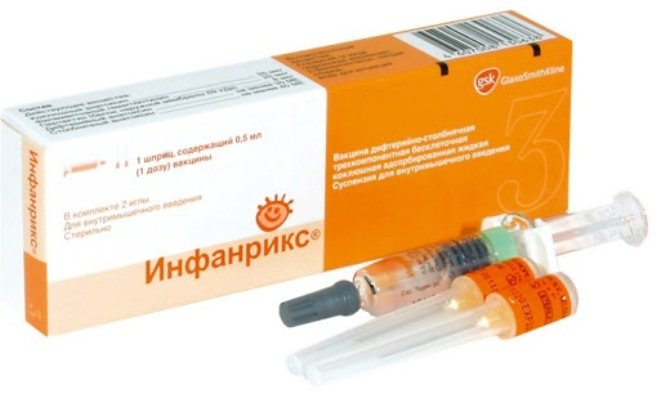
Vaccine Infanrix or Infanrix Hexa: which is better

Infanrix is a three-component vaccine, an improved analogue of the old DTP drug. The product protects against diphtheria, whooping cough and tetanus.
This means that to prevent hepatitis B, polio and Haemophilus influenzae infection, you will have to be vaccinated additionally. It is much more convenient to introduce Hexa, which allows you to develop immunity against six viral pathologies.
Some parents believe that it is better not to load their child with multi-component drugs at a time, and choose a combination of Infanrix with mono-vaccines (the drugs are administered on different days).
So, instead of Hex, you can use Infanrix and Imovax Polio (against polio), Hiberix (protects against Haemophilus influenzae infection), Engerix B (against hepatitis B). This approach is expensive and inconvenient.
Doctors say it is better to use Hexa. It has been clinically proven that the use of multicomponent vaccines reduces the likelihood of adverse reactions and post-vaccination complications.
Advantages of the drug:
- protection against a large number of diseases;
- minimizing stress for the child;
- no time spent on frequent trips to the clinic;
- reduced risk of an allergic reaction.
The company claims that the drug is absolutely safe and can be used to vaccinate children from 3 months of age.
Available - about vaccines

The purpose of vaccinations is to familiarize the body with a possible aggressor so that the immune system can produce protective antibodies. At the same time, figuratively speaking, it is not necessary to invite a criminal into the house - his portrait is enough to get acquainted. This is precisely the role played by transformed microorganisms, on the basis of which vaccines are produced. All types of such drugs have their own characteristics.
"Live" (attenuated) vaccines
They are produced from weakened microorganisms. “Live” vaccines have been altered to such an extent that they can no longer cause disease, but to the immune system they look like the real thing. This type of vaccine is used to prevent measles, mumps, rubella, chickenpox, rotavirus, tuberculosis and polio. Important! Live vaccines provide the most durable immunity - but they are also the most associated with risks. In rare cases, the pathogen can return to an active state and cause disease. This happens when a live polio vaccine is administered (fortunately, there is an alternative in the next group of drugs).
Inactivated vaccines
Such vaccines are created on the basis of a “killed” pathogen. But at the same time, the pathogen remains recognizable to the immune system and becomes a stimulus for the formation of the necessary antibodies. These drugs include whole cell pertussis vaccine and inactivated polio vaccine (IPV). Important! The immune response to killed microbes is weaker than to live ones, but it is still effective. It is impossible to get infected from such a vaccine - there is nothing living in it.
Subunit vaccines
This is no longer just a killed pathogen, but its fragments. The causative agent of the disease is “dissected” by releasing the antigen - the very particle to which immune cells react. This is how the antihemophilic vaccine, the influenza vaccine, and the acellular whooping cough vaccine appear. There are also drugs created using genetic engineering - for example, a vaccine against hepatitis B. Important! There are a minimum of adverse reactions - but some of these vaccines require sequential administration of several doses to form lasting immunity.
Vaccines with toxoid
Such vaccines contain a neutralized bacterial toxin - toxoid. They trigger the production of antibodies against the corresponding toxin. These are, for example, anti-tetanus and anti-diphtheria vaccines. Important! To maintain immunity, revaccination is carried out: children are vaccinated first according to the calendar, and then every 5 years. Adults are vaccinated every 10 years.

Combination vaccines
Yes, there are some. By the way, many parents fear that such drugs “put a lot of stress on the body.” However, you should not be afraid of them: the number of components does not affect the frequency of complications and the severity of post-vaccination reactions. But such vaccines cause minimal discomfort in young patients - instead of three, four or even six injections, only one is needed. The childhood vaccination schedule includes several combined vaccines.
- Hexaxim and Infanrix Hexa include components that help fight diphtheria, whooping cough, tetanus, hepatitis B, polio and Haemophilus influenzae.
- Pentaxim combines vaccines that help fight diphtheria, whooping cough, tetanus, polio and Haemophilus influenzae.
- "Infanrix IPV" and "Tetraxim" consist of DTP (fights diphtheria, whooping cough, tetanus) and inactivated polio vaccine.
- Priorix includes live but attenuated vaccines against measles, mumps and rubella.
Vaccination of children is an important and complex topic. But she has one goal: to protect the body from infections as early and as reliably as possible.
